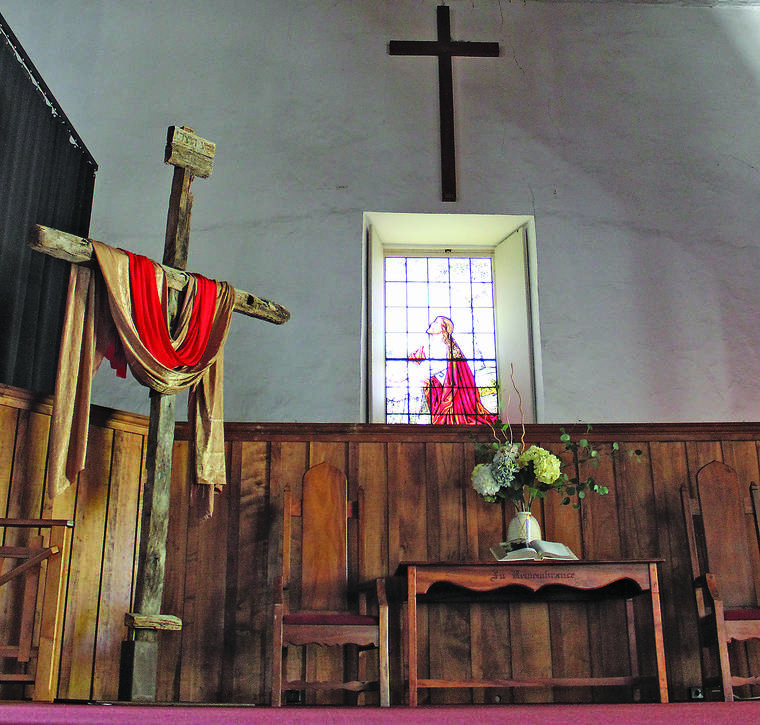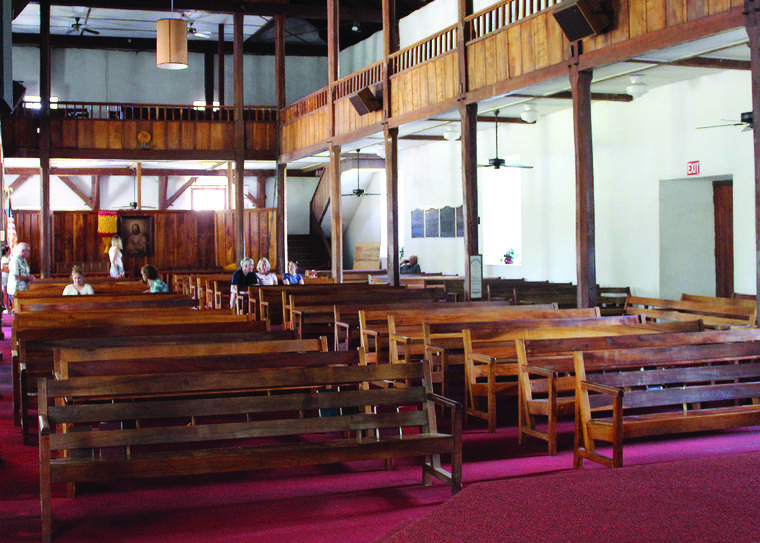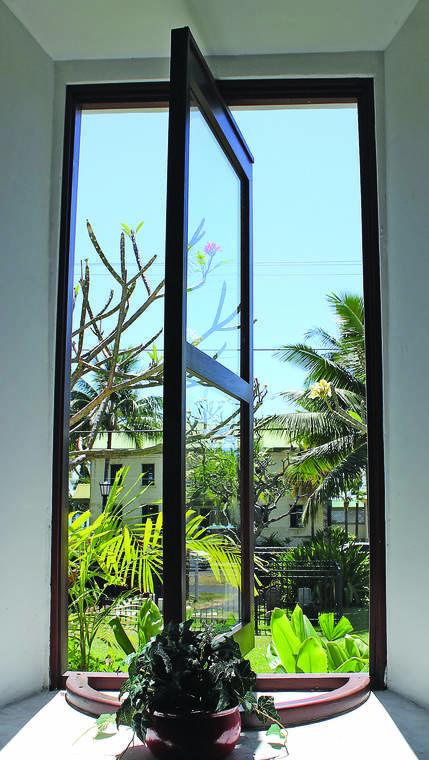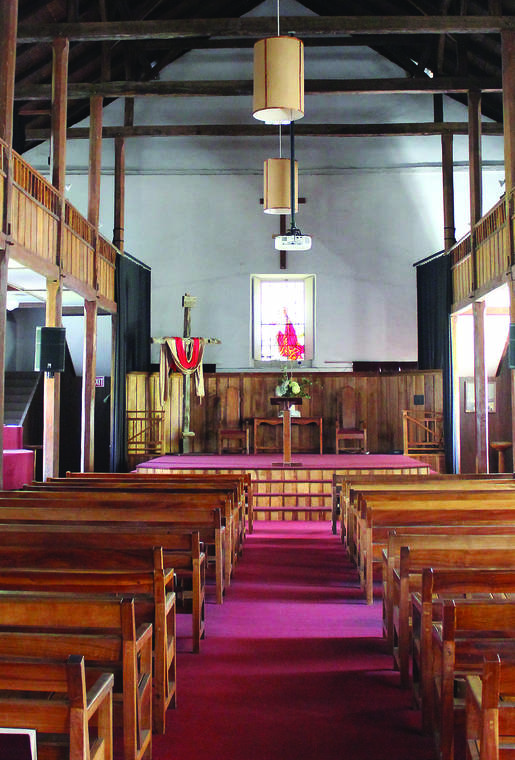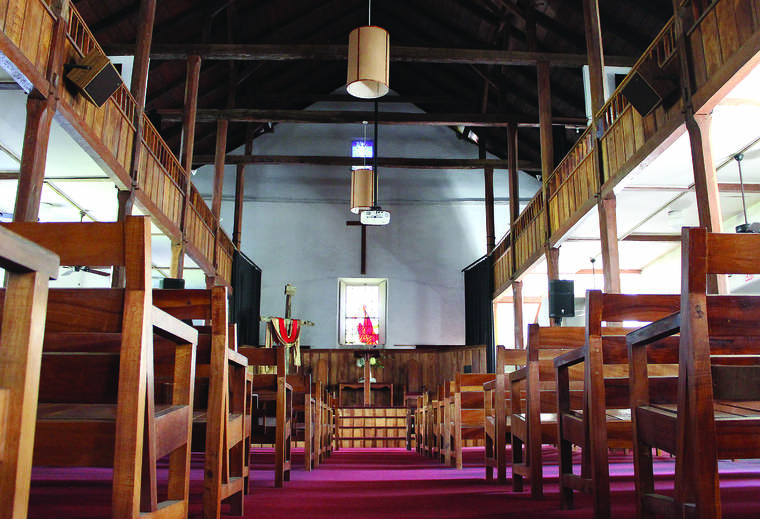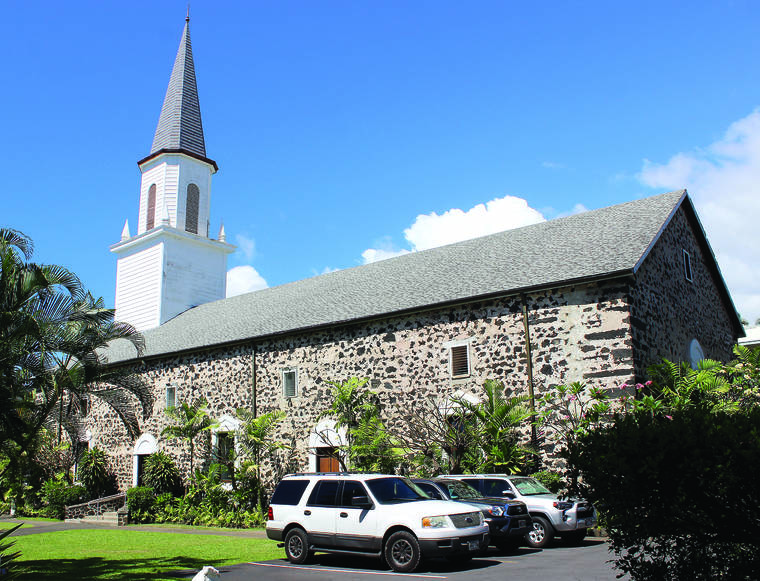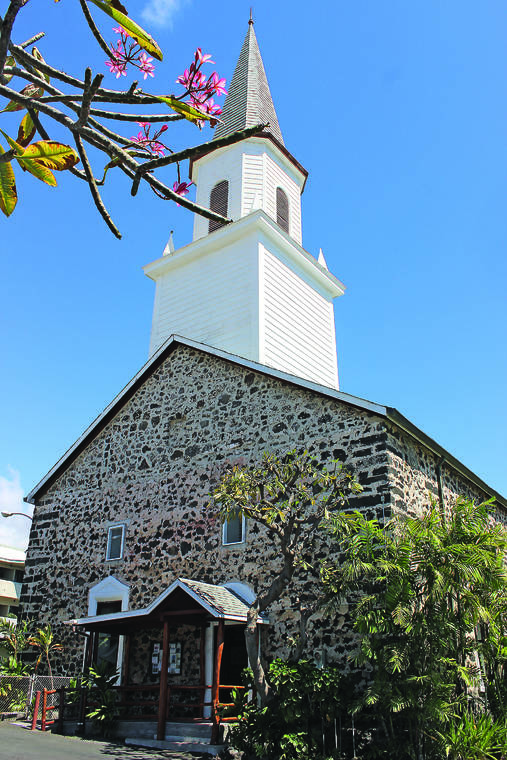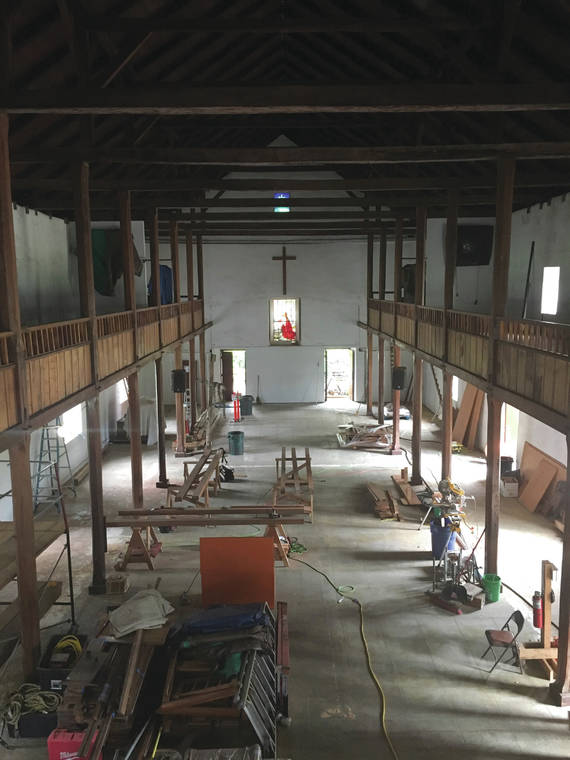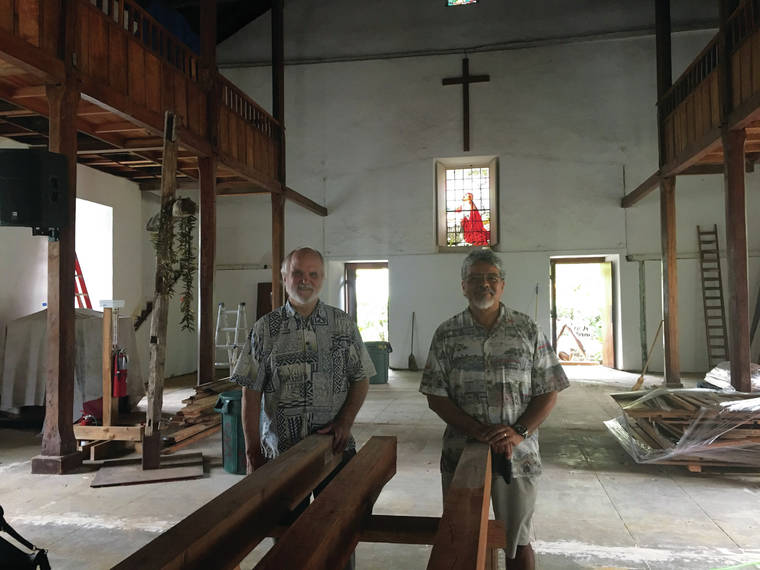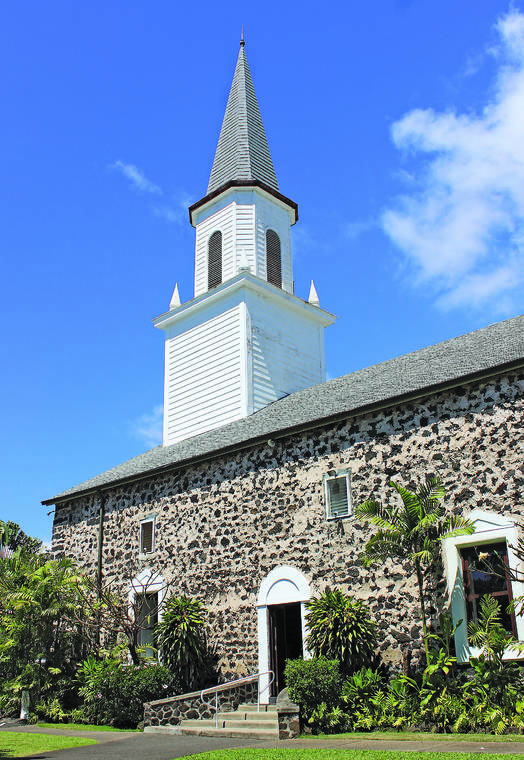A new era: Mokuaikaua Church restoration to be completed by 200th anniversary in April
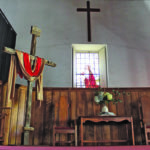
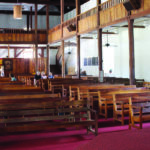
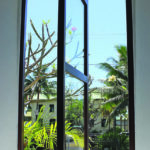
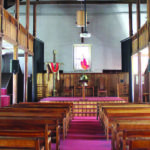
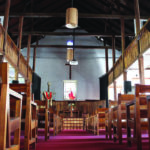
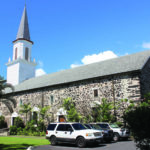
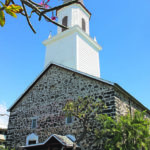
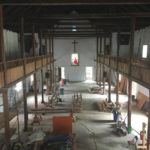
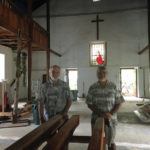
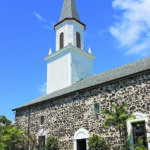
KAILUA-KONA — Through 200 years and waves of drastic change to Kailua-Kona and the Hawaiian islands, Mokuaikaua Church has stood, steady and absolute in its faith.
Maybe it’s a miracle, or maybe it’s the dedication of a few individuals who want the church to last 200 years more.
“After the construction, what we’re looking for is to have this monument here for the next generation,” pastor David de Carvalho said. “But really, the prayer behind this is God will visit the islands the same way he did back in the 1800s.
“It was the passage from the old era into a new era.”
In October, the stripped-down altar, chancel and nave of the church no longer resemble the usual image of where de Carvalho welcomes his flock and visitors alike every Sunday. Since June, the church has been undergoing a restoration project that will bring the church’s historical importance into its next era.
The plan by both the church board and the construction crews is to have the renovations completed by April of next year, in time for the church’s 200th anniversary.
“We’re not sure on the timing of some things because it takes a while,” said Michael Lavelle, lead carpenter for Alii Builders, one of the construction companies tasked to the restoration project. “In April, it’s the 200-year anniversary of Christianity on the island, so they want a celebration for that. We want the majority of it to be accomplished by then.”
The project is currently in its first of two phases. Phase I is fixing three major areas for safety and structural stability of the sanctuary.
The three major areas are: the exterior stone masonry walls, which have three cracks and lack the capability to maintain stability under seismic loads per the current building code; large steel beams will be added to span across the end walls to tie them together with the side walls for stability; and rigidity in the roof system will be increased by adding interior load bearing posts and retro-refitting, hurricane-resistant connections.
“Right now we’re in Phase I-B,” Lavelle said. “And for the next phase, we get to go up into the steeple. It’s 112 feet to the top of the church. There’s a bell up there from 1859, and we have to remove that and they’re going to send that to the mainland for three months, and then it will be brought back here.
“They’re still trying to decide what they’re doing up in there. We may have to remove the steeple because there’s termite damage.”
Phase II of the restoration project also includes improvements to the ohia posts and beams, restoring plaster walls, and replacing electrical wiring.
“The ceiling, the timbers, it’s all hand-hewn,” Lavelle said. “This is first example of Western or European architecture on the islands, so this was when the Hawaiians were introduced to using iron tools. So it was a big change for the islands.”
Nate Hendricks, general contractor for Alii Builders, grew up on Hawaii Island and said the church is a “potent symbol” to the community, and he wanted a local company to be a part of the restoration.
“I wanted to make sure it was done the right way and that the church and the church board was protected,” Hendricks said.
Working alongside Alii Builders for the renovation project is Re-use Hawaii, a nonprofit organization that deconstructs buildings to avoid demolition and recovers the building material to recycle back into use.
“Instead of demolition, we deconstruct. So we take it apart in reverse order that it was built in,” said Ipo Kahulamu with Re-use Hawaii. “The goal of this company is they want to salvage to reuse, recondition, and resell 80% of the building material. And they have displaced, to date, almost 100 million tons of landfill material.
“The primary focus is on lumber, but other stuff gets used too. And then stuff like aluminum, copper, plumbing, and wiring all get recycled so it doesn’t end up in a landfill.”
In 2018, Re-use Hawaii completed 55 deconstruction projects similar to the church’s restoration, and diverted 1,083 tons of building material from the landfill.
“We’re excited to do it because it’s such an important project,” Kahulamu said.
Some material from the church and other Re-use Hawaii deconstruction projects can be purchased by the public at Re-use Hawaii’s redistribution yard, located on Allied Quarry Road in Kailua-Kona.
The deconstruction, not demolition, process is important for Mokuaikaua Church, whose historical importance to Hawaii cannot be overlooked.
“Re-use Hawaii has been, beautifully really, dismantling and then it’s all going to be restored,” said chairman of the church board David Ross.
Ross has been a part of the Mokuaikaua ohana since 1977, and de Carvalho, the church’s 31st pastor, is headed into his ninth year with the church. They have many memories of the church that gives the sanctuary a special place in their hearts and makes saving it their priority.
De Carvalho was previously a pastor for Kalahikiola Congregational Church in Kapaau. He was a part of that church in 2006 when a magnitude-6.7 earthquake shook Hawaii Island and caused the cracks that are now being fixed in Mokuaikaua’s walls.
Kalahikiola Church wasn’t as lucky, which is why de Carvalho is so passionate about the restoration project.
“Three of the four walls came down. They caved in. Here, it only gave us three cracks in the walls. But up in Kohala, it brought the church down,” de Carvalho said.
“He’s really sensitive about it,” Ross said. “I’m like, it will be fine. He goes, ‘No. Not on my watch. We’re going to fix this thing.’ It’s been quite a long road from 2007 when we first got the plans done. And then with nickels and dimes, we started to save up for it.”
When it’s all said and done, the restoration project will cost an estimated $3.1 million. Some of that money has come from donations raised in a fundraiser campaign the church board started years ago.
In May, the church received a gift of $450,000 from a Canadian donor, Alan Quesnel.
The previous month, the church was awarded a $250,000 grant from the National Fund for Sacred Places for the restoration project. The grant was a match for a $250,000 donation made by the company Kennedy Wilson from a request made to the company by Alii Builders’ Hendricks.
The church will celebrate its birthday on April 4, 2020, which is the goal date for renovation completion.
Mokuaikaua Church, the oldest Christian church in Hawaii, was founded in 1820 by Reverend Asa Thurston. Thurston and his wife, Lucy Goodale Thurston, were in the first company of missionaries to arrive on the island. They came to Hawaii on the ship the Thaddeus, which sailed from Boston on a five-month journey to Hawaii Island with 12 other missionaries and four native Hawaiians.
The church was added to the National Register of Historic Places in 1978, and was designated as one of America’s 11 most endangered historic places by the National Trust for Historic Preservation in 2014.
“We sit here in the middle of Kailua-Kona, and I would say that about 5,000 people come through our doors every month,” de Carvalho said. “They’re looking for some history, and so we become special in that way, because we present the passage of eras from old Hawaii to when gospel came to Hawaii. And they learn about the history of Hawaii.
“It is a unique feature right here in the middle of town.”

